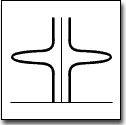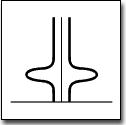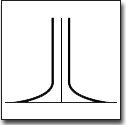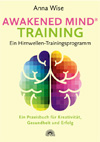|
Brainwaves - and what they represent (part 1)
Brainwaves can be categorized according to their frequency:
- Gamma
- Beta
- Alpha
- Theta
- Delta
|
(100 - 38 Hertz = cycles per second)
(38 - 15 Hz)
(14 - 8 Hz)
(7 - 4 Hz)
(3 - 0,5 Hz)
|
Although logical thinking is often attributed to the left hemisphere and intuitive and creative activities
are seen to be located in the right hemisphere, the Mind Mirror EEG in most people is quite symmetrical. Both hemispheres are very well connected, and
even though there are brain activities that can clearly be located in one hemisphere (e.g. speech), most of the time both hemispheres are active.
The Mind Mirror display shows the brain waves according to their frequencies from top (38 Hz) to bottom (0.5 Hz).
The strength of the signal (amplitude) is determined in how far from the middle the curve reaches outward.
Gamma brainwaves (100 - 38 Hz) were detected later than the other brainwaves, less is known
about them so far. They have been seen in states of peak performance (both physical and mental), high focus and concentration and during mystic and transcendental experiences. A lot of research is currently being done on gamma brainwaves in the 40 Hz range during meditation.
One of the characteristics of gamma waves is a synchronisation of activity over wide areas of the brain.
Gamma brainwaves are not easy to detect because of their low amplitude and can only partly be displayed on the Mind Mirror screen.
Sometimes they may be seen as a narrow frequency band at 38 Hz.
 |
Beta waves (38 - 15 Hz)
are the brainwaves of our "normal" waking consciousness, of our outward attention, of logical, conscious and analytical thinking.
High frequency beta ("splayed beta") is seen with restlessness, stress, anxiety, panic or while our inner critic or commentator
is active. Splayed beta can be differentiated from the low frequency beta of the
awakened mind,
when thinking feels clear, alert, creative and to the point.
|
 |
Alpha brainwaves (14 - 8 Hz)
are seen when we are in a relaxed state, daydreaming or visualizing ("sensualising" seems to be more appropriate
as imagination in all senses - hearing, kinesthetic, smell, taste etc. - stimulates alpha waves. Your visual sense may not necessarily be
the strongest for you. Some people rather feel an inner knowing).
We need alpha waves as the bridge to the lower frequencies of the subconscious (theta), if we want to remember the content of our dreams or our
meditation, or if we want to retrieve information from our subconscious. For this reason alpha is especially important in combination with other brainwaves.
|
 |
Theta (7 - 4 Hz)
represents the subconscious. We see theta during dream sleep (REM sleep), meditation, during peak experiences and creative states.
In theta we find unconscious or suppressed parts of our psyche as well as our creativity and spirituality. Theta images are usually less
distinct and colorful than alpha images, sometimes of a blueish color, but they often feel more profound and meaningful.
As long as we only produce theta brainwaves, their content will stay inaccessible to our waking mind.
We need alpha to bridge the gap between theta and beta brainwaves to consciously experience or remember theta content. |
 |
Delta brainwaves (3 - 0.5 Hz)
are the brainwaves of the lowest frequency and represent the unconscious. If we only produce delta we will find us in
dreamless deep sleep, but we also see delta in various combinations with other brainwaves. They may then represent
intuition, curiosity, a kind of radar, hunches or a "feeling" for situations and other people. Delta is often seen
with people who work in therapeutic environments or professions and with people who have had traumatic experiences
and have developed a "radar" for difficult situations. |
You might have noticed that the "subconscious" and the "unconscious" are used here in almost the same
way as there is no clear distinction or borderline between the two.
Both states are normally inaccessible to the waking mind, and they are less close to our waking consciousness than a phone number
that we usually know by heart but cannot remember in a given moment.
Let us agree to refer to the parts of the personality that normally are not conscious to us (theta) as the "subconscious",
whereas the "unconscious" goes beyond
the individual and includes the "collective unconscious" (C.G. Jung) and transpersonal aspects of consciousness (delta).
On the following page we will look at how the various combinations of these
brainwaves relate to different states of consciousness.
|









